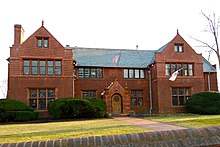
The Ivy League is an American collegiate athletic conference, comprising eight private research universities in the Northeastern United States. The term Ivy League is typically used outside sports to refer to the eight schools as a group of elite colleges with connotations of academic excellence, selectivity in admissions, and social elitism. Its members are Brown University, Columbia University, Cornell University, Dartmouth College, Harvard University, Princeton University, University of Pennsylvania, and Yale University. The conference headquarters are in Princeton, New Jersey.

Princeton University is a private Ivy League research university in Princeton, New Jersey. Founded in 1746 in Elizabeth as the College of New Jersey, Princeton is the fourth-oldest institution of higher education in the United States and one of the nine colonial colleges chartered before the American Revolution. The institution moved to Newark in 1747, and then to its current campus, nine years later. It officially became a university in 1896 and was subsequently renamed Princeton University.
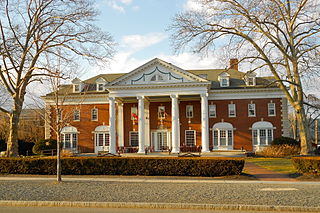
Colonial Club is one of the eleven current eating clubs of Princeton University in Princeton, New Jersey, United States. Founded in 1891, it is the fifth oldest of the clubs. It is located on 40 Prospect Avenue.

Princeton Tower Club is one of the eleven eating clubs at Princeton University in Princeton, New Jersey, United States, and one of seven clubs to choose its members through a selective process called bicker. Tower is located at 13 Prospect Avenue between the university-run Campus Club and the Cannon Club; it currently has a membership of approximately 215.

Tiger Inn is one of the eleven active eating clubs at Princeton University in Princeton, New Jersey. Tiger Inn was founded in 1890 and is one of the "Big Four" eating clubs at Princeton, the four oldest and most prestigious on campus. Tiger Inn is the third oldest Princeton Eating Club. Its historic clubhouse is located at 48 Prospect Avenue, Princeton, New Jersey, near the Princeton University campus. Members of "T.I." also frequently refer to the club as "The Glorious Tiger Inn."

Princeton Terrace Club is one of eleven current eating clubs at Princeton University in Princeton, New Jersey, United States. Terrace Club was founded in 1904 and is located at 62 Washington Road. It is the sole Princeton eating club located off Prospect Avenue.

Allan Marquand was an art historian at Princeton University and a curator of the Princeton University Art Museum. Marquand is notable as one of the foremost art historians and critics of his time, and helped to popularize and establish the field in elite college campuses. Along with his contemporary, Harvard's Charles Eliot Norton, Marquand was the first academic to bring the serious, academic study of art history into American collegiate curricula.
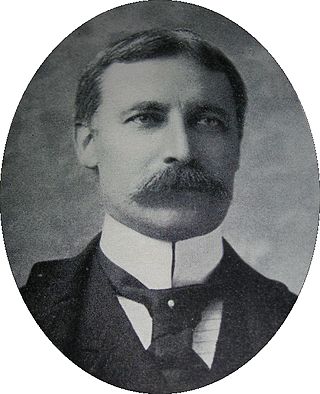
Moses Taylor Pyne, was an American financier and philanthropist, and one of Princeton University's greatest benefactors and its most influential trustee.

Cap and Gown Club, founded in 1891, is an eating club at Princeton University, in Princeton, New Jersey, United States. Colloquially known as "Cap", the club is one of the "Big Four" eating clubs at Princeton. Members are selected through a selective process called bicker. Sometimes known as "the Illustrious Cap and Gown Club," it was the first of the currently selective eating clubs to accept women. Though personalities of eating clubs certainly change throughout the years, Cap and Gown is described in F. Scott Fitzgerald's This Side of Paradise as "anti-alcoholic, faintly religious and politically powerful."

Steven Michael Colloton is a United States circuit judge of the United States Court of Appeals for the Eighth Circuit since 2003. He became chief judge in March 2024.

The University Cottage Club or simply Cottage Club is one of eleven current eating clubs at Princeton University, in Princeton, New Jersey, United States. It is one of the six bicker clubs, along with The Ivy Club, Tiger Inn, Cap and Gown Club, Cannon Club and Tower Club.

The Yale Club of New York City, commonly called The Yale Club, is a private club in Midtown Manhattan, New York City. Its membership is restricted almost entirely to alumni and faculty of Yale University. The Yale Club has a worldwide membership of over 11,000. The 22-story clubhouse at 50 Vanderbilt Avenue, opened in 1915, was the world's largest clubhouse upon its completion and is still the largest college clubhouse ever built.
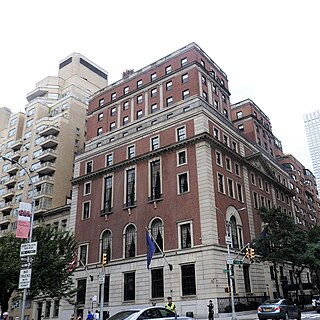
The Union League Club is a private social club in New York City that was founded in 1863 in affiliation with the Union League. Its fourth and current clubhouse is located at 38 East 37th Street on the corner of Park Avenue, in the Murray Hill neighborhood of Manhattan. It was designed by Benjamin Wistar Morris and opened on February 2, 1931. The building was designated a New York City landmark on October 25, 2011. The club is considered one of the most prestigious in New York City.
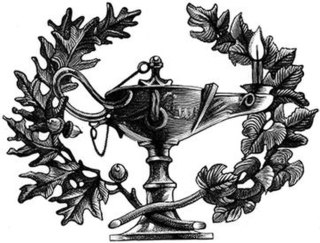
The Century Association is a private social, arts, and dining club in New York City, founded in 1847. Its clubhouse is located at 7 West 43rd Street near Fifth Avenue in Midtown Manhattan. It is primarily a club for men and women with distinction in literature or the arts. The Century Association was founded by members of New York's Sketch Club; preceding clubs also included the National Academy of Design, the Bread and Cheese Club, and the Column. Traditionally a men's club, women first became active in club life in the early 1900s; the organization began admitting women as members in 1988.

Princeton University eating clubs are private institutions resembling both dining halls and social houses, where the majority of Princeton undergraduate upperclassmen eat their meals. Each eating club occupies a large mansion on Prospect Avenue, one of the main roads that runs through the Princeton campus, with the exception of Terrace Club which is just around the corner on Washington Road. This area is known to students colloquially as "The Street". Princeton's eating clubs are the primary setting in F. Scott Fitzgerald's 1920 debut novel, This Side of Paradise, and the clubs appeared prominently in the 2004 novel The Rule of Four.

The Princeton University Rugby Football Club is the college rugby team of Princeton University. The team currently competes in the Ivy Rugby Conference, an annual rugby union competition played among the eight member schools of the Ivy League.
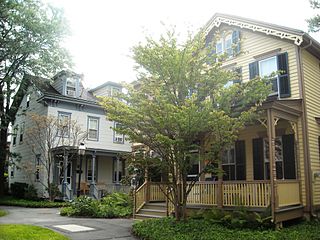
The Princeton Historic District is a 370-acre (150 ha) historic district located in Princeton, New Jersey that was listed on the U.S. National Register of Historic Places in 1975. It stretches from Marquand Park in the west to the Eating Clubs in the East, from the Princeton Cemetery in the north to the Graduate College in the south. The district encompasses the core parts of the campuses of the Princeton Theological Seminary and Princeton University. It also includes the business district centered on Nassau Street and many historic homes, both mansions in the western section and more humble dwellings in the Witherspoon/Jackson neighborhood. Notable churches within the district include Nassau Presbyterian Church, Trinity Episcopal, Nassau Christian Center, and the Princeton University Chapel. The district is home to seven of Princeton's nine, and New Jersey's fifty-eight, National Historic Landmarks, the largest concentration of such sites in the state.

Cannon Dial Elm Club, also known as Cannon Club, is one of the historic Eating Clubs at Princeton University. Founded in 1895, it completed its current clubhouse in 1910. The club closed in the early 1970s and later merged with Dial Lodge and Elm Club to form Dial, Elm, Cannon (DEC), which closed its doors in 1998. In 2011 DEC reopened, now bearing the name Cannon Dial Elm Club, using its historic clubhouse, which had served as the home for the Office of Population Research during the club's hiatus.

The Penn Club of New York is an American 501(c)7 not-for-profit, private social club located on Clubhouse Row in the Midtown Manhattan neighborhood of New York City. The club's 14-story building, which is a designated landmark, is located at 30 West 44th Street and initially was occupied by The Yale Club of New York City.
Sally Frank sued the three all-male eating clubs at Princeton University in 1978 for denying her on the basis of her gender. Over ten years later, in 1990 the eating clubs were defined as "public accommodation" and court ordered to become co-ed thanks to Sally Frank, her attorney Nadine Taub and the Women's Rights Litigation Clinic of Rutgers Law School. The eating clubs argued that they were completely private and separate from the university, giving them the right to sex discrimination. After many rounds in the courts, this argument eventually failed. The winning argument stated that the clubs were in fact not separate, and instead functioned as an arm of the university itself. This meant that the clubs were in the end covered by New Jersey's anti-discrimination law and forced to admit women.





